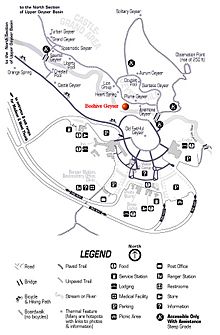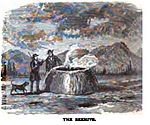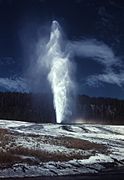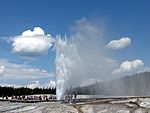Beehive Geyser facts for kids
Quick facts for kids Beehive Geyser |
|
|---|---|

Beehive eruption
|
|
| Name origin | Named on September 18, 1870 by the Washburn-Langford-Doane Expedition |
| Location | Upper Geyser Basin, Yellowstone National Park, Teton County, Wyoming |
| Coordinates | 44°27′47″N 110°49′48″W / 44.4629887°N 110.8299335°W |
| Elevation | 7,362 feet (2,244 m) |
| Type | Cone geyser |
| Eruption height | 200 feet (61 m) |
| Frequency | 8 to 24 hours |
| Duration | 5 minutes |

Southern section of Upper Geyser Basin
|
|
Beehive Geyser is a famous geyser found in Yellowstone National Park in the United States. It is located in the Upper Geyser Basin. This amazing geyser gets its name because its cone looks like a beehive. The cone is about 4-foot (1.2 m) tall. Close by, about 10 feet (3.0 m) away, is a smaller geyser called Beehive's Indicator. It helps predict when Beehive Geyser will erupt!
History of Beehive Geyser
On September 18, 1870, a group of explorers arrived at the Upper Geyser Basin. This group was part of the Washburn–Langford–Doane Expedition. They spent a day and a half exploring this area.
During their visit, they saw seven geysers erupt. They gave names to all of them. Beehive Geyser was one of the geysers they named. Nathaniel Langford, a member of the expedition, described it in 1871. He said the cone was very neat and looked like a beehive.
Langford wrote that they didn't think it was a geyser at first. But one morning, while they were eating breakfast, water shot out of it! The water column went up 219 feet (67 m) high. It stayed mostly straight up in the air. The eruption lasted for 18 minutes. That's when they decided to call it "The Beehive."
How Beehive Geyser Erupts
When Beehive Geyser erupts, it sends water about 200 feet (61 m) into the air. These eruptions usually last for about 5 minutes. The water fountain stays at its full height for most of the eruption. It only drops a little bit near the very end.
After the water stops, a loud steam phase begins. You can hear this roaring steam from a quarter-mile away! The time between eruptions can change. In the summer, it's usually between 16 and 18 hours, or even up to a full day. Winter eruptions are less predictable. Sometimes, in both summer and winter, Beehive will erupt regularly. These regular eruptions happen every 10 to 20 hours. As of summer 2009, Beehive was erupting predictably every 11 to 14 hours.
Beehive's Indicator
There's a smaller geyser very close to Beehive Geyser. It's called Beehive's Indicator. This little geyser is super helpful! It often erupts right before Beehive Geyser does.
The Indicator sends up a fountain of water between 15-to-25-foot (4.6 to 7.6 m) high. It usually starts erupting about 15 to 20 minutes before Beehive. Sometimes it's just a few seconds before, or up to 30 minutes. Once Beehive starts its big eruption, the Indicator keeps going for a bit. Then it stops.
In the 1990s, Beehive Geyser was quiet for three years. During that time, the Indicator would erupt for a long time, sometimes up to 60 minutes. But Beehive itself would not erupt.
- Images of Beehive Geyser
Images for kids






